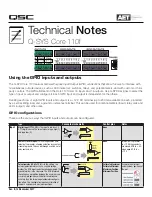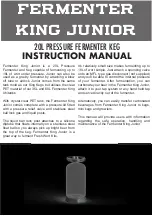
Configuration and Installation
Chapter 2
AT-MIO-16D User Manual
2-36
© National Instruments Corporation
In Figure 2-32, port A is configured for digital output, and port B is configured for digital input.
Digital input applications include receiving TTL signals and sensing external device states such as
the state of the switch in Figure 2-32. Digital output applications include sending TTL signals and
driving external devices such as the LED shown in Figure 2-32.
Power Connections
Pins 34 and 35 of the MIO-16 I/O connector p5 V from the PC AT power supply. These
pins are referenced to DIG GND and can be used to power external digital circuitry.
Power rating:
1 A at +5 V
±
10%
Warning:
These +5 V power pins should not be directly connected to analog or digital ground
or to any other voltage source on the AT-MIO-16D or any other device. Doing so
can damage the AT-MIO-16D and the PC AT. National Instruments is not liable for
damages resulting from such a connection. A spare MIO-16 fuse is provided in case
the power rating is inadvertently exceeded. You should use this fuse only after the
cause of the initial problem is known, so as not to blow the spare fuse as well.
Timing Connections
Pins 36 through 50 of the MIO-16 I/O connector are connections for timing I/O signals. Pins 36
through 40 carry signals used for data acquisition timing. These signals are explained under the
Data Acquisition Timing Connections section later in this chapter. Pins 41 through 50 carry
general-purpose timing signals provided by the onboard Am9513A Counter/Timer. These signals
are explained under the General-Purpose Timing Signal Connections section later in this chapter.
Data Acquisition Timing Connections
The data acquisition timing signals are SCANCLK, EXTSTROBE*, START TRIG*, STOP
TRIG, and EXTCONV*.
SCANCLK is an output signal that generates a high-to-low edge whenever an A/D conversion
begins. SCANCLK pulses only when scanning is enabled on the AT-MIO-16D. SCANCLK is
normally high and pulses low for approximately 1
µ
sec after the A/D conversion begins. The low-
to-high edge signals that the input signal has been acquired. This signal can be used to clock
external analog input multiplexers. The SCANCLK signal is driven by one LS TTL gate.
A low pulse is generated on the EXTSTROBE* pin when the External Strobe Register is loaded
(see the External Strobe Register section in Chapter 4, Programming). Figure 2-33 shows the
timing for the EXTSTROBE* signal.
t
w
approx. 200 nsec
V
OH
t
w
V
OL
-
Figure 2-33. EXTSTROBE* Signal Timing
Summary of Contents for AT-MIO-16D
Page 16: ......
Page 23: ......
Page 185: ......
Page 206: ......
Page 207: ......
Page 208: ......
Page 209: ......
Page 210: ......
Page 211: ......
Page 212: ......
Page 213: ......
Page 214: ......
Page 215: ......
Page 216: ......
Page 217: ......
Page 218: ......
Page 219: ......
Page 220: ......
Page 221: ......
Page 222: ......
Page 223: ......
Page 224: ......
Page 225: ......
Page 226: ......
Page 227: ......
Page 228: ......
Page 229: ......
Page 230: ......
Page 231: ......
Page 232: ......
Page 233: ......
Page 234: ......
Page 235: ......
Page 236: ......
Page 237: ......
Page 238: ......
Page 239: ......
Page 240: ......
Page 241: ......
Page 242: ......
Page 243: ......
Page 244: ......
Page 246: ......
Page 247: ......
Page 248: ......
Page 249: ......
Page 250: ......
Page 251: ......
Page 252: ......
Page 253: ......
Page 254: ......
Page 255: ......
Page 256: ......
Page 257: ......
Page 258: ......
Page 259: ......
Page 260: ......
Page 261: ......
















































